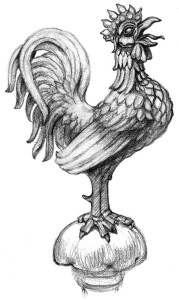Through the Garden Gate—March 2016
March, Who Are You Calling Chicken?
By Leslie Watkins
Permaculture is the conscious design of agricultural systems that behave like natural ecosystems. According to Graham Bell, “It is the harmonious integration of the landscape with people providing their food, energy, shelter and other material and non-material needs in a sustainable way.”
One principle of permaculture is that the less you travel for your food (and the less your food travels to reach you) the smaller your carbon footprint. And there is no easier trip than the one to your own backyard. By living consciously and simply we can make a profound impact on our planet and eat fresh, delicious and healthy food in the process.

St. Vitus’s rooster, © Leslie Watkins, 2016
For thousands of years and right up until the 1950’s it was commonplace for both country and town dwellers alike to keep small flocks of chickens in their backyards. In addition to providing fresh meat and eggs, chickens assist us with pest and weed control and give us a simple source of fertilizer. They help control the tick population and add life to the garden. If you grow your own vegetables, having a compost heap helps feed the microorganisms in the soil, and chickens are the ultimate composters. They not only turn the compost, aerate the soil, eat bugs and kitchen scraps, but they add manure as they go along—prolifically!
Chickens have lived alongside humans for over 7,000 years. They are among the most common of domesticated animals. They have consistently provided us with food, feathers and entertainment. Cock fighting is the oldest continuous sport in the world, though it’s now illegal in every state of the union.
Descendants of dinosaurs, birds are the living representatives of a dinosaur lineage called the Maniraptorans. The notorious non-avian Velociraptor and even some members of the tyrannosaur group were probably adorned with feathers, though they were too heavy to fly. Chickens, Gallus gallus domesticus, originated from the red junglefowl found in Southeast Asia, China, Southern India and the Middle East. The chicken’s portability ensured its rapid spread around the world. Today chickens are the most ubiquitous bird on Earth.
Ancient Persians and Greeks believed the rooster’s crow at dawn summoned the new day. It signified the cosmic turning point between darkness and light, the sign of goodness. Therefore the chicken was associated with spiritual awakening. In Mesopotamia the “royal bird of Meluhha” is believed to refer to the chicken. The rooster also symbolized ferocity and was depicted on battle shields. For Christians, the cock represents Peter’s denial of Christ. Rooster weathervanes sit atop many churches today keeping a watchful vigilance against evil.
Chickens are smarter than you think. Recent scientific studies and reviews confirm that chickens possess abilities far beyond those of a mere “bird brain”. These include various modes of communication including language, decision-making, complex social structures, self-control, emotions and other cognitive abilities. Chickens are far higher in the pecking order than previously understood, in some cases on a par with primates.
Chickens can recognize and differentiate between over 100 human or animal faces. They are playful, they grieve for each other and they feel pain, fear and distress. Hens are wonderful and attentive mothers—they talk to their chicks while still in the egg, and roosters will give their lives to protect the flock.
Backyard Chickens:
Are not overcrowded into inhumane cages as are factory chickens.
Have access to fresh air, sunshine and bugs.
Are friendly and even affectionate.
Make great gardening companions.
Provide hilarious home-grown entertainment.
Backyard Chicken Eggs vs. Battery/Factory Chickens:
Have more than seven times the Vitamin A and Beta Carotene.
Have almost double the Vitamin E.
Contain 292 mg of essential Omega 3 fatty acids vs. battery eggs at 0.033 mg.
Have less saturated fats.
Are free from pesticides, hormones and antibiotics.
